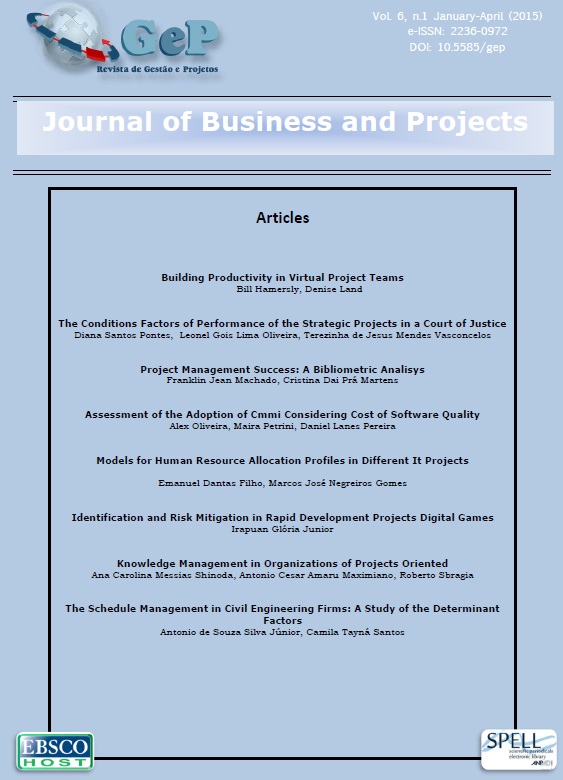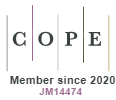Models for Human Resource Allocation Profiles in Different It Projects
DOI:
https://doi.org/10.5585/gep.v6i1.271Keywords:
Project Management, Human Resource Allocation, RCPSP, RCMPSP.Abstract
The project management has been applied in many areas in special Information Technology (IT) companies have increasingly using project management methodologies. Institutions that performs IT projects periodically have demands for human resources allocation. This task is normally done manually, which makes it expensive and sensitive to under allocations. It is needed allocate all of the resources in the most several project activities, always paying attention to the different affinities that the professionals have according to their profile. In this scenario, the aim of this study is to evaluate and develop structured mathematical programming models to optimize the allocation of human resources from different profiles into activities of IT projects. The research developed was of type applied and explanatory, regarding to the nature and the objectives; experimental, regarding to the procedure; and quantitative, regarding to the approach. The experiments were done using real data projects extracted from a software factory, which in general lines the results revealed a cost saving of 15% in labor hours and higher agility in adopting mathematical models to define the allocations. This results contribute to IT project be completed better plans in budget and schedule.
References
Al-Fawzan, M. A., & Haouari, M. (2005). A bi-objective model for robust resource-constrained project scheduling. International Journal of Production Economics, 96(2), 175–187.
Baar, T., Brucker, P., & Knust, S. (1999). Tabu search algorithms and lower bounds for the resource-constrained project scheduling problem (pp. 1-18). Springer US.
Boctor, F. F. (1993). Heuristics for scheduling projects with resource restrictions and several resource-duration modes. The Internacional Journal of Production Research, 31(11), 2547-2558.
Bowers, M. R., Groom, K., & Morris, R. (1996). A practical application of a multi-project scheduling heuristic. Production and Inventory management Journal, 37(4), 19.
Bouleimen, K. L. E. I. N., & Lecocq, H. O. U. S. N. I. (2003). A new efficient simulated annealing algorithm for the resource-constrained project scheduling problem and its multiple mode version. European Journal of Operational Research, 149(2), 268-281.
FILHO, E. D., GOMES, M. J. N. Um método para auxiliar as estimativas de atividades em projetos de TI. III Simpósio Internacional de Gestão de Projetos, 2014, São Paulo-SP.
Gagnon, M., d'Avignon, G., & Aouni, B. (2012). Resource‐constrained project scheduling through the goal programming model: integration of the manager's preferences. International Transactions in Operational Research, 19(4), 547-565.
Hartmann, S. (1998). A competitive genetic algorithm for resource‐constrained project scheduling. Naval Research Logistics (NRL), 45(7), 733-750.
Kerzner, H. R. (2013). Project management: a systems approach to planning, scheduling, and controlling. (11th ed.). New York: John Wiley & Sons.
Kolisch, R., & Hartmann, S. (2006). Experimental investigation of heuristics for resource-constrained project scheduling: An update. European Journal of Operational Research, 174(1), 23-37.
Lamoréa, F. M. M, Higashi, T. B., Ruschel, R. C., Fabricio, M. M. (2007). Técnicas de coordenação: o uso de extranets, sobreposição de projetos e listas de checagem. In: Workshop Brasileiro de gestão do processo de projetos na construção de edifícios, Curitiba.
Murch, R. (2000). Project Management: best practices for IT professionals (1st ed.). United States: Prentice Hall.
Project Management Institute (PMI). (2013). A Guide to the Project Management Body of Knowledge (PMBOK® Guide) (5th ed.). Autor.
Reifer, D. J. (2002). A Little Bit of Knowledge Is a Dangerous Thing. IEEE Software, 19(3), 14-15.
Rus, I., Halling, M., & Biffl, S. (2003). Supporting decision-making in software engineering with process simulation and empirical studies. International Journal of Software Engineering and Knowledge Engineering, 13(05), 531-545.
Silva, A. R. V., Ochi, L. S., & Santos, H. G. (2008, June). New effective algorithm for dynamic resource constrained project scheduling problem. In Proc. of Int. Conf. on Eng. Optim. (ENGOPT), Rio de Janeiro, Brazil (June 2008).
Vargas, R. V. (2009). Gerenciamento de projetos: estabelecendo diferenciais competitivos (7a ed.). Rio de Janeiro: Brasport.
Downloads
Published
How to Cite
Issue
Section
- Abstract 231
- PDF (Português (Brasil)) 161








